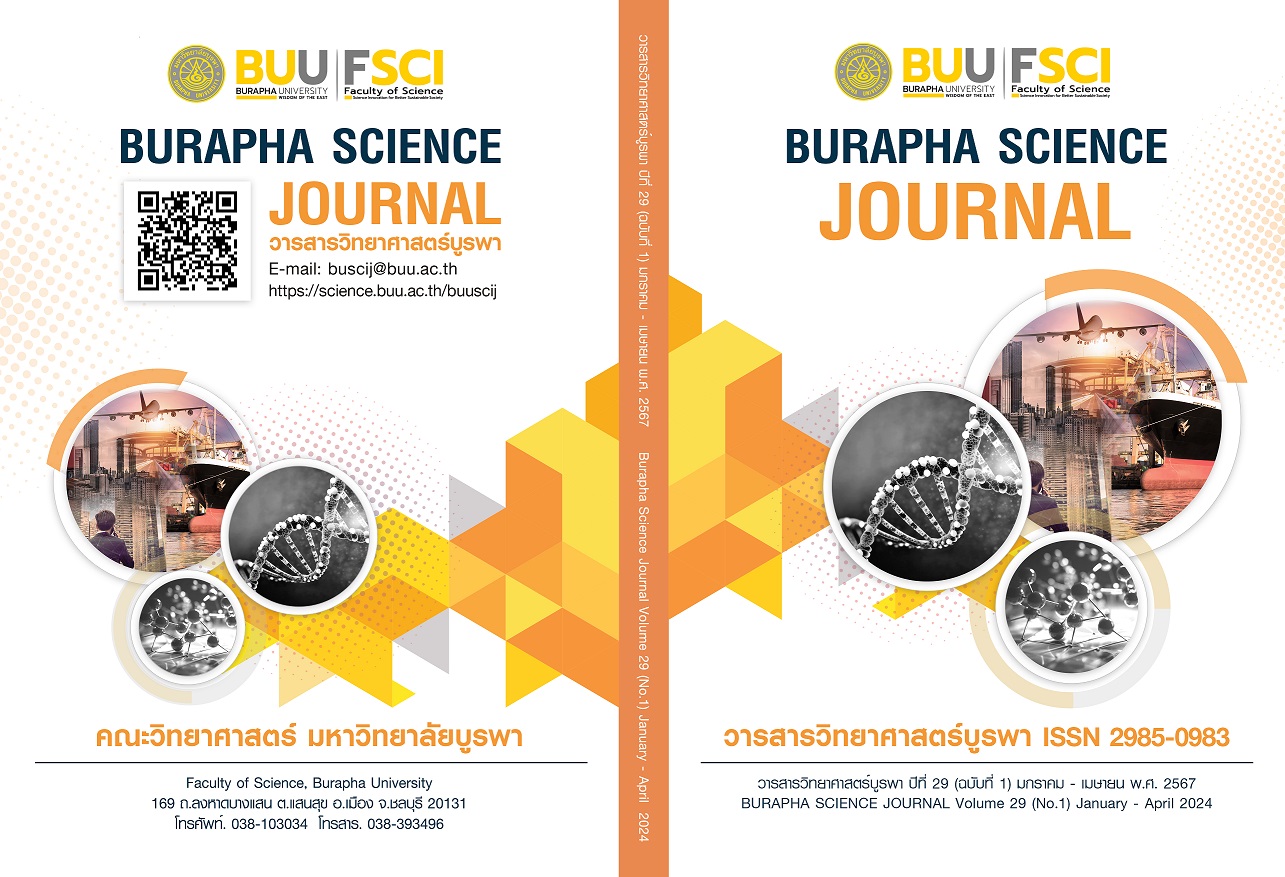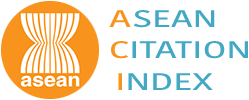การเปลี่ยนแปลงคุณภาพน้ำตามฤดูกาลของอ่างเก็บน้ำบางพระ และ ลำคลองใกล้เคียง จังหวัดชลบุรี
คำสำคัญ:
คุณภาพน้ำ, อ่างเก็บน้ำบางพระ, การเปลี่ยนแปลงตามฤดูกาลบทคัดย่อ
วัตถุประสงค์และที่มา : อ่างเก็บน้ำบางพระเป็นแหล่งน้ำจืดที่สำคัญในการผลิตน้ำประปาเพื่ออุปโภคบริโภคในเขตพื้นที่จังหวัดชลบุรี และพื้นที่ใกล้เคียง หากคุณภาพน้ำในอ่างเก็บน้ำเสื่อมโทรมลงก็จะส่งผลกระทบต่อการดำรงชีวิตของประชาชนและการพัฒนาเศรษฐกิจในภาคอุตสาหกรรม การศึกษาวิจัยครั้งนี้จึงมีวัตถุประสงค์เพื่อศึกษาและประเมินคุณภาพน้ำของอ่างเก็บน้ำบางพระและลำคลองใกล้เคียง โดยนำข้อมูลที่ได้ไปใช้ในเป็นแนวทางในการเฝ้าระวังคุณภาพน้ำที่มีการเปลี่ยนแปลงตามฤดูกาล ซึ่งจะส่งผลกระทบต่อการใช้น้ำเพื่อการอุปโภค บริโภค
วิธีดำเนินการวิจัย : เก็บตัวอย่างน้ำในเดือนสิงหาคม 2562 ถึงเดือนกรกฎาคม 2563 โดยแบ่งเป็นสถานีลำคลอง 5 สถานี และในอ่างเก็บน้ำ 1 สถานี ซึ่งปัจจัยที่ศึกษาประกอบด้วย คุณภาพน้ำทั่วไป (อุณหภูมิของน้ำ พีเอช ออกซิเจนละลายน้ำ บีโอดี ของแข็งแขวนลอย คลอโรฟิลล์ เอ) และสารอนินทรีย์ละลายน้ำ (แอมโมเนียรวม ไนไตรท์ ไนเตรท ซิลิเกต และฟอสเฟต)
ผลการวิจัย : คุณภาพน้ำทั่วไป ได้แก่ อุณหภูมิ พีเอช ออกซิเจนละลายน้ำ บีโอดี ของแข็งแขวนลอยทั้งหมด และคลอโรฟิลล์เอ มีค่าเฉลี่ย เท่ากับ 30.2±2.7 oC, 7.7±0.6, 5.1±1.8 mg/l, 2.8±1.7 mg/l, 23.9±40.2 mg/l และ 7.0±11.5 µg/l ตามลำดับ ส่วนสารอาหาร อนินทรีย์ละลายน้ำ พบว่า แอมโมเนียรวม ไนเตรท และฟอสเฟต มีค่าเฉลี่ยเท่ากับ 44.5±71.0 329.9±1,864.1 และ 3.1±2.6 µM ตามลำดับ นอกจากนี้ยังพบว่าคุณภาพน้ำมีความแตกต่างตามฤดูกาล (p<0.05) โดยคุณภาพน้ำมีแนวโน้มเสื่อมโทรมลงในฤดูฝน
สรุปผลการวิจัย : ผลการวิจัยการเปลี่ยนแปลงคุณภาพน้ำตามฤดูกาลของอ่างเก็บน้ำบางพระและลำคลองใกล้เคียง ในจังหวัดชลบุรี สรุปได้ว่าคุณภาพน้ำทั่วไปของอ่างเก็บน้ำบางพระและลำคลองใกล้เคียง ส่วนใหญ่มีค่าอยู่ในเกณฑ์มาตรฐานคุณภาพน้ำผิวดินประเภทที่ 2 (เพื่อการอุปโภค บริโภค, เพื่อการอนุรักษ์สัตว์น้ำ และเพื่อการประมง) และสามารถนำไปใช้เป็นน้ำดิบในการผลิตน้ำประปาได้ อย่างไรก็ตามควรมีการเฝ้าระวัง ปริมาณออกซิเจนละลายน้ำ ซึ่งมีค่าต่ำกว่ามาตรฐานในบางฤดูกาล
เอกสารอ้างอิง
American Public Health Association - APHA (1992). Standard Methods for the Examination of Water and Wastewater including Sediments and Sludges (18th ed.). American Public Health Association, American Water Works Association and the Water Environment Federation, Washington DC., USA.
American Public Health Association – APHA. (1998). Standard Methods for the Examination of Water and Wastewater (20th Ed.). American Water Works Association, and Water Environment Federation, Washington DC., USA.
Astuti, L.P., Sugianti, Y., Warsa, A., & Sentosa, A.A. (2022). Water Quality and Eutrophication in Jatiluhur Reservoir, West Java, Indonesia. Pol. J. Environ. Stud. 31(2), 1-11. doi:10.15244/pjoes/142475
Brkic, Z. (2023). Increasing water temperature of the largest freshwater lake on the Mediterranean islands as an indicator of global warming. Heliyon, 9(8), e19248. doi.org/10.1016/j.heliyon.2023.e19248
Downing, J. A., & McCauley, E. (1992). The nitrogen: phosphorus relationship in lakes. Limnology and Oceanography, 37(5), 936-945. doi.org/10.4319/lo.1992.37.5.0936
Freire, L., Costa, A., & Lima Neto, I. (2023). Effects of rainfall and land use on nutrient responses in rivers in the Brazilian semiarid region. Environ Monit Assess,195:652. doi:10.1007/s10661-023-11281-y
Grasshoff, K., Kremling, K., & Ehrhardt, M. (1999). Methods of Seawater Analysis 3rd Eds. Weinheim: Wiley-VCH.
Guan, X., Jiang, P., Meng, Y., Qin, H., & Lv, H. (2020). Study on Production, Domestic and Ecological Benefits of Reservoir Water Supply Based on Emergy Analysis. Processes, 8, 1435. doi:10.3390/pr8111435
Gunbua, V. (2020). Plankton Community Structure in Bangphra reservoir, Chonburi province (Research Reports). Chonburi: Burapha university. (in Thai)
Guo, J., Peng, Y., Wang, S., Zheng, Y., Huang, H. , & Wang, Z. (2009). Long-Term Effect of Dissolved Oxygen on Partial Nitrification Performance and Microbial Community Structure. Bioresource Technology, 100, 2796-2802. doi.org/10.1016/j.biortech.2008.12.036
Jargal, N., Atique, U., Mamun, M., & An, K.-G. (2021). Seasonal and Long-Term Connections between Trophic Status, Sestonic Chlorophyll, Nutrients, Organic Matter, and Monsoon Rainfall in a Multipurpose Reservoir. Water, 13, 1720. doi:10.3390/w13131720
Jingyuan C., Hanling X., Yafei C., Chenyu S., Yao Q., Sheng Z., & Haiping Z. (2023). Improved eutrophication model with flow velocity-influence function and application for algal bloom control in a reservoir in East China. Journal of Environmental Management, 348, 119209. doi.org/10.1016/j.jenvman.2023.119209
Latif, S. D., Birima, A. H., Ahmed, A. N., Hatem, D. M., Al-Ansari, N., Fai, C. M., & El-Shafie, A. (2022). Development of prediction model for phosphate in reservoir water system-based machine learning algorithms. Ain Shams Engineering Journal, 13(1), 101523. doi.org/10.1016/j.asej.2021.06.009
Lam, Q., Schmalz, B., & Fohrer, N. (2012). Assessing the spatial and temporal variations of water quality in Lowland areas, Northern Germany. Journal of Hydrology, s 438–439, 137–147. doi:10.1016/j.jhydrol.2012.03.011
McCabe, K., Smith, E., Lang, S., Osburn, C., & Benitez-Nelson, C. (2021). Particulate and Dissolved Organic Matter in Stormwater Runoff Influences Oxygen Demand in Urbanized Headwater Catchments. Environmental Science & Technology, 55 (2) 952-961. doi:10.1021/acs.est.0c04502
Meksumpun, C. (2020). Reservoir hydro-ecology for conservative management. Kasetsart University, Bangkok (Thailand). Faculty of Fisheries. 302 pp. (in Thai)
Meteorological Department of Thailand –TMD. (2020). Average monthly rainfall in Chonburi Province. Bangkok. (in Thai)
Meteorological Department of Thailand –TMD. (2023). Average monthly rainfall in Chonburi Province. Bangkok. (in Thai)
Moursi, H., Youssef, M. A., Poole, C. A., Castro-Bolinaga, C. F., Chescheir, G. M., & Richardson, R. J. (2023). Drainage water recycling reduced nitrogen, phosphorus, and sediment losses from a drained agricultural field in eastern North Carolina, U.S.A. Agricultural Water Management, 279, 108179. doi.org/10.1016/j.agwat.2023.108179
Peerapornpisal, Y., Sonthichai, W., Suchotiratana , M.,Lipigorngoson, S., Ruangyuttikarn, W., Ruangrit, K., (2002). Survey and monitoring of toxic cyanobacteria in waterresources for water supplies and fisheries in Thailand. Chiang Mai Journal of Science, 29(2), 71–79. (in Thai)
Pichitkul,P. (2006). Water quality in Nong Plalai Reservoir. Proceedings of 44th Kasetsart University Annual Conference Fisheries. 341-348. The Thailand Research Fund, Bangkok. (in Thai)
Pongswat,S., Suphan,S., Ritthisorn S., & Rujit,B. (2013). A Study on Water Quality and theAmount of Certain Minerals in the Area Above and Inside Hot Spring Pipe, in the Bang Phra Reservoir,Chonburi Province, from May to August 2011 Burapha Science Journal, 18(2), 179-194. (in Thai)
Pollution Control Department-PCD. (2006). Surface Water Quality Standards & Criteria in Thailand. Ministry of Science, Technology and Environment. (in Thai)
Royal Irrigation Department – RID. (2021). Water database system in reservoirs in Thailand. Bangkok (in Thai)
Salehi, M. (2022). Global water shortage and potable water safety; Today’s concern and tomorrow’s crisis. Environment International, 158, 106936. doi:10.1016/j.envint.2021.106936
Sithikanchanakul, S., & Wanpensakul, J. (2017). The Use of Phytoplankton as Water Quality Indicator in naruebodingdrachinta reservoir, prachinburi povince. Scientific and environmental research. Office of Research and Development, Royal Irrigation Department.
Sirisuriyakamonchai, A. (2012). Water Quality in the Prasae Reservoir, Rayong Province. Department of Fisheries. Bangkok.
Sirisuriyakamonchai, A., Budsara,S., & Anan,K. (2022). Water Quality in Pasak Jolasid Reservoir. Department of Fisheries, Kaset campus, Chatuchak. Bangkok. 7/2022. (in Thai)
Smith, V.H., Tilman, G.D., & Nekola, J.C. (1999). Eutrophication: impacts of excess nutrient inputs on freshwater, marine, and terrestrial ecosystems. Environmental Pollution, 100(1-3):179-96. doi: 10.1016/s0269-7491(99)00091-3. PMID: 15093117.
Strickland, J.D.H., & Parsons, T.R. (1972). A Practical Handbook of Seawater Analysis. Fishery Research Board of Canada, Ottawa.
Thapichitburapa, P., & Meksumpun, C. (2021). The Effects of Dissolved Inorganic Nutrients on Eutrophication Situationsof Trat Bay, Trat Province. Burapha Science Journal, 26(2), 770-782. (in Thai)
Wang, H., Liang, X.-M., Jiang, P.-H., Wang, J., Wu, S., & Wang, H. (2008). TN : TTP ratio and planktivorous fish do not affect nutrient-chlorophyll relationships in shallow lakes. Freshwater Biology, 53, 935-944. doi:10.1111/j.1365-2427.2007.01950.x
Yang, N., Zhang, C., Wang, L., Li, Y., Zhang, W., Niu, L., Zhang,H., & Wang, L. (2021). Nitrogen cycling processes and the role of multi-trophic microbiota in dam-induced river-reservoir systems. Water Research, 206, 117730. doi.org/10.1016/j.watres.2021.117730
Zeng, X., & Rasmussen, T. (2005). Multivariate Statistical Characterization of Water Quality in Lake Lanier, Georgia, USA. Journal of environmental quality, 34, 1980-1991. doi:10.2134/jeq2004.0337
Zhang, Y., Li, M., Dong, J., Yang, H., Van Zwieten, L., Lu, H., & Wang, H. (2021). A Critical Review of Methods for Analyzing Freshwater Eutrophication. Water, 13(2). doi:10.3390/w13020225
ดาวน์โหลด
เผยแพร่แล้ว
รูปแบบการอ้างอิง
ฉบับ
ประเภทบทความ
สัญญาอนุญาต
ลิขสิทธิ์ (c) 2024 คณะวิทยาศาสตร์ มหาวิทยาลัยบูรพา

อนุญาตภายใต้เงื่อนไข Creative Commons Attribution-NonCommercial-NoDerivatives 4.0 International License.
Burapha Science Journal is licensed under a Creative Commons Attribution-NonCommercial-NoDerivatives 4.0 International (CC BY-NC-ND 4.0) licence, unless otherwise stated. Please read our Policies page for more information




